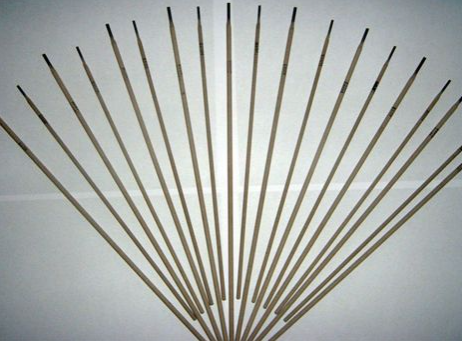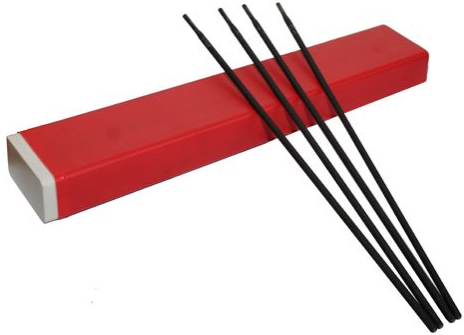An electrode is essentially a coated metal wire. It should normally be made of a material with properties and composition similar to the metal being welded, and there are a number of factors that can be taken into account in selecting the right electrode for your particular project.
While shielded metal arc welding (SMAW) or 'stick' electrodes are expendable and form part of the weld, other electrodes (such as those used for TIG welding) are non-expendable, meaning they do not melt and separate from the weld, which case a welding rod is required.
The choice of the correct electrode is crucial in terms of seam strength, bead quality, minimizing spatter, and clean-up.
Cellulose electrodes
A cellulose electrode is a welding electrode covered in a coating containing organic material. Typically, approximately 30% of the coating weight is cellulose, but in some countries of the world, pulp and wood flour may be added to the coating to reduce the amount of pure cellulose.

AWS ECI
The various organic compounds in the electrode will break down in the arc to form carbon dioxide, carbon monoxide, and hydrogen, each of which will increase the tension within the arc, resulting in a stronger, harder arc. As a result, cellulose electrodes can penetrate to a depth of up to 70% compared to compatible electrodes with the same current value.
Usually produced with thin or medium-thickness coatings, this results in significant spatter loss although it does produce slag which can be cleaned off after the welding process is complete. However, the vertical downward welding and penetration capability of this electrode are very good due to the gap filling of the coating.
The main characteristics of cellulose electrodes are
Deep penetration.
Can be welded vertically downwards.
You can weld metals with good mechanical properties.
Smaller melt pools are formed.
Low-hydrogen electrodes
Low-hydrogen electrodes are essentially a protective metal arc welding (SMAW) consumable with a water content of less than 0.6% compared to the more traditional 4-6% in cellulose electrodes.
As a general rule, low hydrogen electrodes such as the E7018 rod electrode provide the user with low spatter levels and a smooth, stable and quiet arc. These characteristics make these electrodes an excellent choice for experienced welders or beginners learning the ropes. The properties of these filler metal electrodes provide the welder with excellent arc control and minimise the need for post weld clean up.
Unlike other electrodes such as E6010 or E6011, low hydrogen electrodes offer excellent deposit and penetration rates, allowing the welding operator to add more weld metal to the joint at any time, thereby increasing the strength of the weld while avoiding weld defects such as lack of fusion.

AWS A5.11 ENiCrFe-3
The main features of low hydrogen electrodes are
Good permeability.
Good deposition.
Quiet arc characteristics.
Low spatter levels.
Good fusion.
Mild steel electrodes
As a general rule of thumb, mild steel electrodes provide a quiet and stable arc with low penetration, which makes them ideal for bridging wide gaps and working with thin plates. However, there are various different types of mild steel electrodes, each with slightly different properties and therefore better suited to different applications.
For example, Grade 6013 is a general purpose mild steel electrode that provides deep penetration while maintaining a smooth and stable arc. This electrode has an easily regenerated arc, an attractive weld path, low spatter and easy slag control, making it suitable for standing down welding.
The final mild steel electrode we will see is 6011, a versatile and deep penetrating electrode that gives you a smooth and stable arc for welding galvanised mild steel and some other low alloy steels. Its coating produces a powerful and deep penetrating arc with a thin slag layer that is easy to remove.
Stainless steel electrodes
As with the other electrodes we have seen above, the stainless steel electrode once again comes in a series of variations, each slightly different from the previous one.
Here we will look at the 3 different grades of stainless steel electrodes, 308, 309 and 316, and when to use them.
If you use types 301, 302, 304, 305 and the foundry alloys CF-3 and CF8 then we recommend that you use 308L, including the ER308LSi electrodes. These stainless steel electrodes are ideal for use with austenitic stainless steels, but for applications such as the power industry we recommend using 308H as this high carbon electrode provides better creep resistance for high temperature applications.
When joining mild steel or mild steel alloys to stainless steel, 309L should be used, including ER309LSi. This is also the case when joining different stainless steels, such as 409 to itself or 304L stainless steel. In addition, they should also be used for joining 309 base metals.
When using 316L and 316 base metals and their cast equivalents CF-8m and CF-3M, you should only use 316L, including ER317LSi, as a filler metal.
Some 308L applications can use 309L as a filler metal instead as they do not require molybdenum, unlike 316 or 316L applications that require molybdenum, so you cannot use 309 instead of 316.
Typical applications for the various stainless steel welding electrodes include
Bellows.
Heat exchangers.
Furnace components.
Expansion joints.
Aircraft exhaust manifolds.
Heating element tubes.
Woven wire mesh welding for high temperature processing of minerals.
Repair and maintenance of electrodes
As we have seen above, there is a wide range of electrodes available. Each one has slightly different properties and therefore has a slightly different and unique function. When carrying out any repair and maintenance work, you must ensure that the electrodes you use have the required characteristics.
First, determine what metal you will be repairing or maintaining. Then you must determine whether you need a universal electrode or an electrode with specific properties. Once you have gathered all this information you can start welding if you don't and you use the wrong electrode your welding is likely to fail or you could burn right through the metal you are working with.







